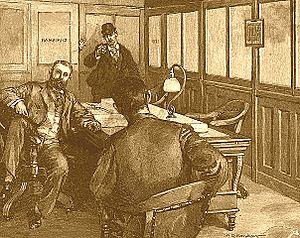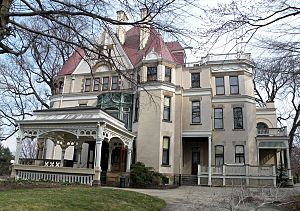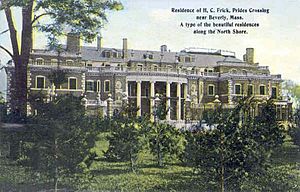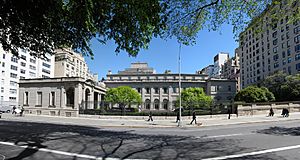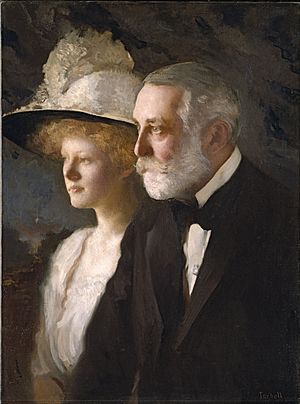Henry Clay Frick facts for kids
Quick facts for kids
Henry Clay Frick
|
|
|---|---|
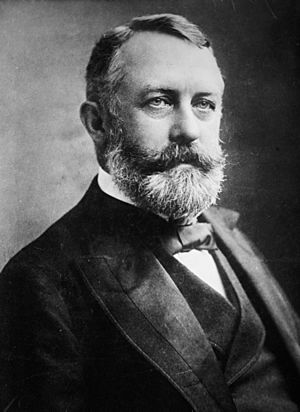 |
|
| Born | December 19, 1849 West Overton, Pennsylvania, United States
|
| Died | December 2, 1919 (aged 69) New York City, United States
|
| Resting place | Homewood Cemetery, Pittsburgh, Pennsylvania |
| Nationality | American |
| Education | Otterbein University (did not graduate) |
| Occupation | Industrialist and art collector |
| Known for | Strikebreaking, Frick Collection, Johnstown Flood |
| Spouse(s) | Adelaide Childs Frick (1859–1931) |
| Children | Childs Frick, Martha Frick, Helen Clay Frick, Henry Clay Frick Jr. |
| Signature | |
 |
|
Henry Clay Frick (December 19, 1849 – December 2, 1919) was a very successful American businessman and art collector. He started a company that made coke, a special fuel used to make steel. He also led the Carnegie Steel Company and helped create the huge U.S. Steel company.
Frick owned a lot of land and helped build railroads. He also collected many famous paintings and beautiful furniture. These artworks are now part of the well-known Frick Collection and art museum in New York City. However, Frick was also involved in some difficult events. He was partly responsible for changes to a dam that led to the terrible Johnstown Flood. He also had strong disagreements with workers, which caused a violent conflict known as the Homestead strike.
Contents
Henry Frick's Early Life
Frick was born in West Overton, Pennsylvania, in 1849. His family had Swiss and German roots. His grandfather owned a successful whiskey distillery.
When Frick was 21, he started a small business with friends. They used special ovens called beehive ovens to turn coal into coke. Coke was very important for making steel. Frick wanted to be a millionaire by the time he was 30.
With help from his friend Andrew Mellon's family, Frick bought out his partners by 1880. His company was called H. C. Frick & Company. It grew very big, employing 1,000 workers. It controlled most of the coal production in Pennsylvania.
Working with Andrew Carnegie
In 1881, Frick met Andrew Carnegie, another famous businessman. This meeting led to a partnership between Frick's company and Carnegie's steel company. This partnership made sure Carnegie's steel mills always had enough coke. Frick became the chairman of the company.
Over time, Carnegie tried to push Frick out of the company. Even though Frick had helped Carnegie make a lot of money, Carnegie often ignored his ideas about important business decisions.
The Johnstown Flood Disaster
Frick was a member of a group called the South Fork Fishing and Hunting Club. This club was located high above the city of Johnstown, Pennsylvania. The club members were wealthy business leaders.
They owned a private lake called Lake Conemaugh, which was held back by a very large earthen dam. The city of Johnstown was less than 20 miles (32 km) downstream from this dam.
The club made some changes to the dam that made it weaker. They also put a screen across the dam's spillway to stop fish from escaping. This screen partly blocked the water flow.
On May 31, 1889, after heavy rains and melting snow, the dam broke. This caused the terrible Johnstown Flood. The flood killed 2,209 people and caused a lot of damage.
When news of the dam breaking reached Pittsburgh, Frick and other club members formed a committee to help the flood victims. They also agreed never to talk publicly about the club or the flood. Lawsuits against the club members were stopped, and no one was officially blamed.
The Homestead Strike
Frick and Carnegie had disagreements about how to handle a major worker strike. This was the Homestead Steel Strike in 1892. Workers at the Carnegie Steel Company's Homestead factory went on strike. They were upset about their wages and working conditions.
Frick was known for being against labor unions. He ordered a tall fence with barbed wire to be built around the factory. Workers called it "Fort Frick."
Frick hired private security guards, called Pinkerton agents, to remove the striking workers by force. The Pinkerton agents arrived on barges. A big fight broke out between the workers and the agents. Ten people died, most of them workers, and many more were injured.
The Pinkerton agents were forced to leave. The state militia, a group of armed soldiers, had to step in to stop the fighting. Frick then told the workers that if they didn't return to work, they would lose their jobs and even their homes.
Many Americans thought Frick's actions against the strikers were too harsh. He became a target for union organizers.
Attempted Assassination
During the Homestead Strike, a man named Alexander Berkman tried to kill Frick. This happened on July 23, 1892. Frick was badly hurt but was back at work within a week. Berkman was sent to prison.
The news of the assassination attempt made the public feel less supportive of the strike. This led to the strike ending. Many workers lost their jobs, and those who stayed had their wages cut in half.
Henry Frick's Private Life
Henry Frick married Adelaide Howard Childs in 1881. They had four children: Childs, Martha, Helen, and Henry Jr. Two of their children, Martha and Henry Jr., died when they were very young.
In 1882, Frick and his wife bought a home in Pittsburgh that they called Clayton. Their children grew up there.
Frick loved collecting art. He gathered a huge collection of paintings and other beautiful items. By 1905, Frick moved his main interests to New York City. He took his art collection with him.
The Frick Collection in New York is now one of the best collections of European paintings in the United States. It has many artworks from different time periods. Besides paintings, it also displays carpets, porcelain, sculptures, and old furniture. Frick lived in his New York mansion and at Clayton until he passed away.
Frick owned a fancy private railroad car called the Westmoreland. It cost almost $40,000 in 1910. It had a kitchen, dining room, and several bedrooms. Frick used it to travel between his homes and to places like Florida.
In 1912, Frick and his wife had tickets to travel on the first trip of the RMS Titanic. Luckily, they canceled their trip because Adelaide sprained her ankle. This saved them from the ship's tragic sinking.
Henry Clay Frick died on December 2, 1919, just before his 70th birthday. He was buried in Homewood Cemetery in Pittsburgh.
Henry Frick's Legacy
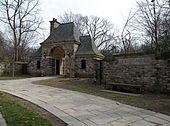
In his will, Frick left a large piece of land to the City of Pittsburgh. This land became a public park called Frick Park, which opened in 1927. He also left money to help maintain the park. Over time, more land was added to the park, making it much larger.
After his wife Adelaide died in 1931, the Frick Collection was opened to the public as a museum in 1935.
Many years later, Frick's daughter, Helen Clay Frick, returned to live at the Clayton estate. After she died, Clayton was also opened to the public in 1990 as the Frick Art & Historical Center.
Henry Clay Frick's Business Records
The records of Henry Clay Frick's business dealings from 1849 to 1919 are kept in an archive. These documents show how American steel and coal industries grew during that time. They include letters from important businessmen like Andrew Carnegie and J. P. Morgan. Many of these records can be viewed online. They are very important for understanding the history of the Pittsburgh area.
See also
 In Spanish: Henry Clay Frick para niños
In Spanish: Henry Clay Frick para niños



